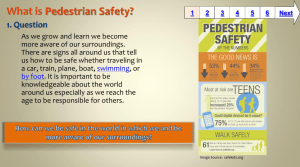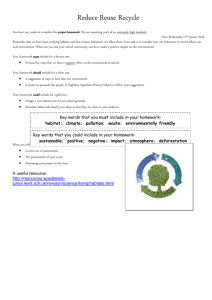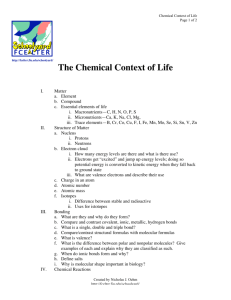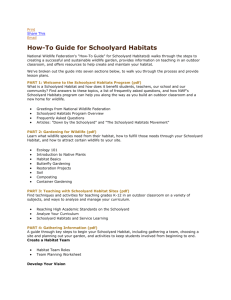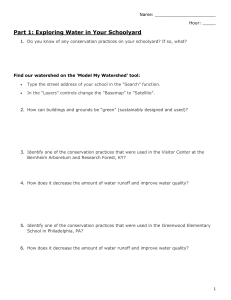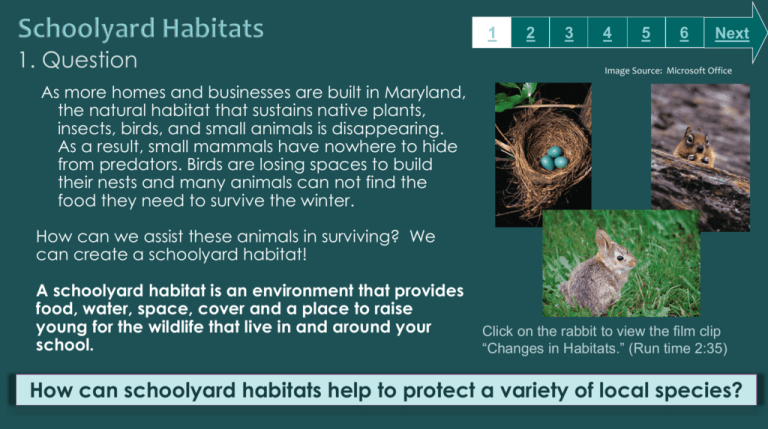
1
1. Question
2
3
4
5
6
Next
Image Source: Microsoft Office
As more homes and businesses are built in Maryland,
the natural habitat that sustains native plants,
insects, birds, and small animals is disappearing.
As a result, small mammals have nowhere to hide
from predators. Birds are losing spaces to build
their nests and many animals can not find the
food they need to survive the winter.
How can we assist these animals in surviving? We
can create a schoolyard habitat!
A schoolyard habitat is an environment that provides
food, water, space, cover and a place to raise
young for the wildlife that live in and around your
school.
Click on the rabbit to view the film clip
“Changes in Habitats.” (Run time 2:35)
How can schoolyard habitats help to protect a variety of local species?
2. Information Sources
1
2
3
4
5
6
Next
Using the resources below, learn about the environment that you could encounter
around your school. Record your findings here. Use the glossary if you struggle with any
of the science words.
Forest resources
Wetland resources Other resources
What is a forest?
World Book Student –
Wetland
Check out the photo gallery
“Fire in the Wild”
EPA- Wetlands
World Book Student – Forests BrainPOP Jr.– Freshwater
habitats
BrainPOP Jr.– Forests
BrainPOP Jr. – Soil
*NOTE: Go to the BCPS Database page and click on
BrainPOP Jr., then return to this slide and click on the
video link above.
Exploring Nature – Meadows
Maryland Native Plants – Coastal Plain
(skip to page 9 for complete list)
*NOTE: Go to the BCPS Database page
and click on BrainPOP Jr., then return to
this slide and click on the video link
above.
*NOTE: Go to the BCPS Database page
and click on BrainPOP Jr., then return to
this slide and click on the video link above.
Maryland Native Plants – Piedmont
(skip to page 9 for complete list)
World Book Kids - Forests
World Book Kids - Wetland
Serpentine – Grasslands
3. Student Activity
1
It is now time to head outside the library and into
your school yard!
Using a device that can take video and/or
pictures, work in teams to document the
habitat outside of your school.
Use this checklist to make sure that you record
all of the findings that you need.
Image Source: clipart.com by
subscription
2
3
4
5
6
Next
4. Assessment Activity
1
2
3
4
5
Now it is your turn to answer the focus question:
How can schoolyard habitats
help protect a variety of local
species?
You will take the information that you’ve learned
about habitats AND the pictures and videos
from your own schoolyard to construct a public
service announcement for your school.
Your PSA could be created in one of these formats:
Morning announcements - Rubric
Video for announcements – Rubric
Use the Rubrics to help you do your best work!
Image Source: clipart.com by subscription
6
Next
5. Enrichment Activities
1
2
3
4
5
6
Next
Habitat – Living Things Game
Image Source: BBC Schools – Science Clips
Image Source: Discovery Education
Whaddaya Know Quiz Show – Animal habitats
6. Teacher Support Materials
1
2
3
4
5
6
Grade 4 – Library Media
Standards
See attached document.
Time Frame: 2 class periods in the Library, 1 class period in the schoolyard
Differentiation strategies for this lesson:
Database content features audio read-aloud, labeled reading levels/Lexiles, closed-captioned video.
Learning Styles addressed in this lesson:
Visual, Auditory, Kinesthetic, Active, Reflective, Global Understanding
Notes to the teacher:
Collaborate with your 4th grade classroom teacher s to implement this lesson.
To implement a schoolyard habitat, refer to this guide from the National Wildlife Foundation.
On Slide 2, the sources marked with a
are more challenging resources.
On Slide 2, in the column titled “Other Resources”, you can eliminate one of the Maryland Native Plants –
Coastal Plain or Piedmont resources depending upon your location in Baltimore County. See this map for your
location.
Last updated: July 2015
Created by Jamie Higgins Shaull, Department Chair – Social Studies/Library Media Cohort graduate
BCPS Slam Dunk Research Model, Copyright 2014, Baltimore County Public Schools, MD, all rights reserved. The models may be used for educational, non-profit school use only.
All other uses, transmissions, and duplications are prohibited unless permission is granted expressly. This lesson is based on Jamie McKenzie’s Slam Dunk Lesson module.



